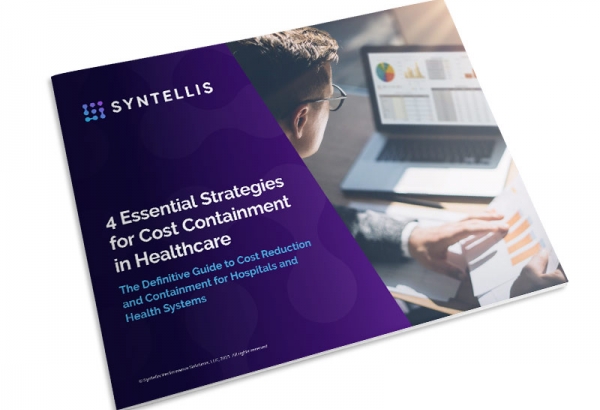What is cost containment in healthcare?
Cost containment in healthcare is a comprehensive strategy that integrates efforts to reduce an organization’s existing costs and control current and future costs. Effective cost containment moves beyond more traditional, one-off cost-cutting initiatives. While such initiatives may lead to short-term savings, the benefits tend to wane over time or are offset by rising expenses in other areas.
To reverse these trends, healthcare leaders should take a more global cost containment approach, incorporating it as an ongoing part of routine organizational processes. With a cost containment strategy, healthcare finance professionals work with leaders across the organization to continuously monitor and analyze expenses and identify opportunities to reduce costs and prevent or minimize further cost growth.
Why is healthcare cost containment important?
The need for hospitals, health systems, and other healthcare organizations to implement continuous, systemwide cost containment strategies has never been greater. Numerous factors have contributed to significant industry volatility in recent years. These include the ongoing repercussions of the pandemic, economic turbulence, shifts in patient demand, increased competition for core outpatient services, mounting funding pressures, and evolving risk- and value-based payment models.
These factors have caused margin, volume, and revenue fluctuations, but healthcare expenses have remained consistently high nationwide. This upward trajectory of costs is unsustainable and threatens the long-term viability of critical healthcare services.
According to a recent Syntellis survey, more than 80% of healthcare finance professionals cited cost containment as very important to helping their organizations maintain or rebuild their fiscal health.
What are the benefits of cost containment in healthcare?
True cost containment enables organizations to effectively address rising costs. A sound cost containment strategy provides healthcare leaders:
-
A comprehensive approach to managing costs
-
Ongoing visibility to the drivers of organizational costs
-
A means to integrate clinical and financial management
-
Greater transparency on productivity trends
-
Data and analytics to reveal opportunities to reduce inefficiencies and improve care quality
-
Sustainable cost reduction and cost control results
How do organizations implement a healthcare cost containment strategy?
Four tips to help healthcare executives implement an effective cost containment strategy at their organizations are:
- Improve understanding of organizational costs. To address rising costs, healthcare leaders must first understand the drivers behind those costs. This requires continuously evaluating costs at all levels across an organization, including supplies, labor, facility needs, maintenance, and clinical performance.
For example, hospital leaders should track supply chain cost and utilization data on purchased products and services through to individual patient encounters. They should then analyze this data to gauge the hospital’s performance against internal and external benchmarks, project future demand, and guide purchasing plans. Analyzing supply chain data helps leaders ensure purchased products and services are being used as intended, identify variations across departments or facilities, and pinpoint other areas for potential savings.
-
Build engagement organizationwide. Healthcare leaders need to build a culture of cost containment that permeates the entire organization and supports ongoing performance improvement. Maintaining buy-in and input from stakeholders across different departments, facilities, and service lines can help leaders better understand cost drivers and identify realistic, sustainable cost containment targets.
Having the support of physicians and other frontline clinical and support staff is essential in developing actionable cost containment strategies, as they likely will be the ones executing many of those strategies day-to-day. Tips for helping to build engagement organizationwide include:
-
Link labor costs and productivity. Labor costs can account for as much as 60% of an organization’s total costs. Tying labor costs to physician and staff productivity can help uncover inefficiencies. It also can help leaders determine how best to allocate labor resources to improve workflows, minimize downtime, and ensure appropriate staffing levels to meet patient demands.
Healthcare leaders should collaborate with clinical and departmental leaders to evaluate labor costs and establish reasonable productivity targets that maintain high standards for care quality. By analyzing productivity in conjunction with fluctuations in patient volumes, leaders can help identify optimal staffing levels, including how to flex staffing as volumes change.
-
Provide robust tools for data-driven decision-making. Clinical leaders, departmental managers, and others across an organization working to implement healthcare cost containment strategies need the right tools to be successful. Analyzing and monitoring expenses, cost and utilization trends, patient volumes, productivity, and other performance metrics relative to targets require modern cost accounting, comparative analytics, and clinical comparison solutions. Organizations need access to accurate cost data and analytics at all stages of implementing cost containment initiatives.
Who should be involved in the cost containment process?
Making cost containment an intrinsic part of everyday operations requires broad awareness and buy-in across an organization. In addition to the finance team and executives, healthcare leaders should seek input from stakeholders across different departments, facilities, and service lines. Working in collaboration with physicians and other frontline clinical and support staff on an ongoing basis is vital to understanding cost drivers and identifying actionable cost control strategies for healthcare. In turn, those physicians and clinicians can serve as ambassadors to help build engagement among their peers.
What are the barriers to an effective cost containment strategy?
A lack of knowledge and tools are the most significant barriers to implementing effective cost containment strategies in healthcare. Awareness about the importance of comprehensive cost containment has grown in recent years, but many healthcare leaders lack the tools to successfully tackle complex cost structures at their organizations.
Syntellis’ survey of healthcare finance professionals found:
Fewer than half (48%) said cost accounting processes at their organizations were optimized for efficiency, accuracy, and savings. More than two-thirds (68%) said they did not have advanced decision support solutions that provide a high degree of confidence in performance tracking and management.
Integrated tools for cost containment
Syntellis’ Axiom Healthcare Suite offers healthcare leaders access to robust, accurate, and timely cost and budgeting data and analytics on a single, integrated platform. Specifically, Axiom’s Enterprise Decision Support alerts healthcare leaders to unfavorable trends, providing a comprehensive and detailed view across cost, quality, and service line measures. This granular detail helps inform decision-making to drive improved financial, clinical, and operational performance.
LEARN MORE ABOUT COSTING METHODOLOGIES IN HEALTHCARE

4 Essential Strategies for Cost Containment in Healthcare


